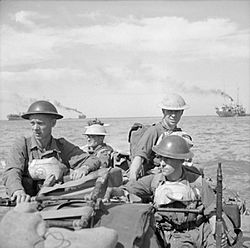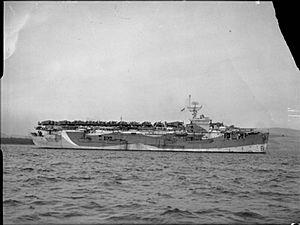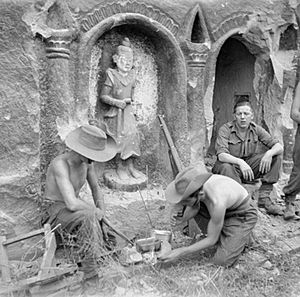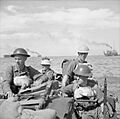Battle of Ramree Island facts for kids
Quick facts for kids Battle of Ramree Island |
|||||||
|---|---|---|---|---|---|---|---|
| Part of The Burma campaign | |||||||
 British troops in landing craft make their way ashore on Ramree Island, 21 January 1945. |
|||||||
|
|||||||
| Belligerents | |||||||
| Commanders and leaders | |||||||
| Cyril Lomax | Kan'ichi Nagazawa | ||||||
| Units involved | |||||||
| Two brigades, 26th Indian Infantry Division; one squadron, 146 Regt, RAC, elements of 3 Commando Brigade | 2nd Battalion, 121st Regiment, 54th Division | ||||||
| Strength | |||||||
| c. 6,000 | c. 1,000 | ||||||
| Casualties and losses | |||||||
| "trifling" | c. 500 killed 20 captured c. 500 evacuated to the mainland |
||||||
The Battle of Ramree Island was a fight during World War II. It happened from January 14 to February 22, 1945. This battle was part of the larger Burma campaign, where Allied forces fought against Japanese forces. Ramree Island is off the coast of Burma (now Myanmar).
The island was important because it was a good place to build airfields. These airfields would help supply Allied troops fighting on the mainland. The battle is famous for a story about hundreds of Japanese soldiers being attacked by crocodiles in the island's swamps. However, many experts today say this story is not entirely true.
Contents
Why Was Ramree Island Important?
Ramree Island is about 70 miles (110 km) south of Akyab (now Sittwe). It covers an area of 520 square miles (1,350 km²). The island is separated from the mainland by a narrow channel.
Japanese forces had taken control of Ramree Island in 1942. By January 1945, the Allies wanted to capture it back. They needed the island to build airfields. These airfields would help their planes support the ground troops.
Getting Ready for Battle
The 26th Indian Infantry Division was chosen to attack Ramree Island. This division was led by Major-General Henry Chambers. The attack was planned for January 21. A small group of Royal Marines also went to Cheduba Island nearby.
The Japanese soldiers on Ramree Island were from the II Battalion, 121st Infantry Regiment. They were led by Colonel Kan'ichi Nagazawa. They had artillery and engineers to help them defend the island.
The Attack Begins
The battle started with an operation called "Matador." The goal was to capture the port of Kyaukpyu on Ramree Island. This port was important, and there was an airfield nearby.
On January 14, Allied scouts found that the Japanese had placed artillery in caves. These caves overlooked the beaches where the Allies planned to land. So, the Royal Navy sent many warships to help. These included the battleship HMS Queen Elizabeth and the aircraft carrier HMS Ameer.
On January 21, an hour before the troops landed, the warships began firing. The Queen Elizabeth fired huge 15-inch shells. Planes from the Royal Air Force also bombed and strafed the beaches.
The Battle on Ramree Island
The Allied troops landed on the beaches near Kyaukpyu. They faced no resistance at first. By the afternoon, they had secured the beachhead. The next day, more troops landed and took control of Kyaukpyu.
On January 23, the 71st Infantry Brigade moved south along the coast. They met more Japanese resistance as they moved inland. On January 31, the 71st Brigade was ordered to move towards Ramree town.
On January 26, Royal Marines landed on Cheduba Island, which was empty. On Ramree, the Japanese fought hard. But on February 1, the 71st Indian Infantry Brigade reached Sane.
When the British surrounded a Japanese stronghold, about 900 Japanese soldiers left their base. They tried to join a larger Japanese force across the island. Their path led them through 10 miles (16 km) of thick mangrove swamps.
Trapped in the Swamps
As the Japanese struggled through the swamps, the British surrounded the area. The soldiers were trapped in deep mud. They also faced tropical diseases, scorpions, mosquitoes, and saltwater crocodiles.
On February 7, the 71st Indian Infantry Brigade and tanks reached Ramree town. The Japanese fought fiercely there. The town finally fell on February 9. The navy and the 26th Indian Infantry Division then blocked the small streams (called chaungs) on the east coast. This was to stop the Japanese from escaping to the mainland.
On February 11, a Japanese air raid damaged a British destroyer. The Japanese also sent about 40 small boats from the mainland to rescue their soldiers. Japanese resistance on the island ended on February 17. The Allied blockade continued until February 22. Many Japanese rescue boats were sunk, and many soldiers hiding in the swamps were killed. About 500 Japanese troops managed to escape.
What Happened After the Battle?
The British won the Battle of Ramree Island. About 500 Japanese soldiers were killed, and 20 were captured. Around 500 more managed to escape. British losses were very small.
The Crocodile Story
The Battle of Ramree Island is most famous for the story of crocodiles attacking Japanese soldiers.
On February 24, 1945, news reporters said that Japanese soldiers trying to escape were "being forced by hunger out of the mangrove swamps and many have been killed by crocodiles."
A Canadian naturalist named Bruce Wright wrote about the battle in 1962. He said that the night of February 19, 1945, was "the most horrible" for the boat crews. He described "the screams of wounded men crushed in the jaws of huge reptiles." Wright claimed that out of about 1,000 Japanese soldiers who went into the swamps, only about 20 were found alive.
This story was even put into the Guinness Book of World Records as the worst animal attack ever. Other soldiers also believed the crocodiles played a big part. One British soldier wrote that the crocodiles "killed hundreds of them." Lieutenant-General Jack Jacob of the Indian Army also said, "It is not difficult to imagine what happened to the Japanese who took refuge in the mangroves!"
What Do Experts Say Now?
However, many historians and animal experts doubt the story of a massive crocodile attack.
- In 2011, historian Frank McLynn questioned the idea of "thousands of crocodiles" in the swamp. He said that the swamp's environment probably couldn't support so many large crocodiles.
- In 1974, a journalist asked the Japanese War Office about the crocodile attack. They said they could not confirm it happened.
- In 2016, historian Sam Willis found documents suggesting that most Japanese soldiers drowned or were shot. He believed crocodiles might have eaten their bodies afterward, but didn't kill them.
- In 2000, a reptile expert named Steven Platt visited Ramree Island. He talked to people who lived there during the war. They said that only about 10 to 15 soldiers were killed by crocodiles while trying to cross a creek. Platt concluded that while nearly 1,000 Japanese soldiers died, crocodiles probably didn't cause most of those deaths.
- Platt also found that Bruce Wright, who wrote the famous account, was not on Ramree Island during the main battle. Wright arrived later and likely heard stories from others. Wright's own later book, The Frogmen of Burma, also mentioned that the Japanese died from thirst and wounds, not just crocodiles.
So, while crocodiles were present and likely a danger, the idea that they killed hundreds of soldiers is probably an exaggerated story.
Images for kids




